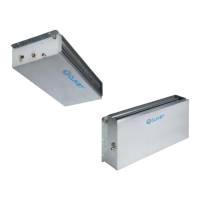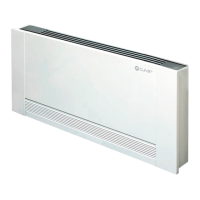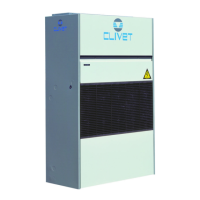Do you have a question about the CLIVET ELFODuct HP 015.0 and is the answer not in the manual?
Information about the manual's purpose, how to use it, and key symbols.
States that only qualified personnel can operate the unit.
Discusses risks during design, installation, and operation by inexperienced personnel.
Specifies the intended applications for the unit and manufacturer's disclaimer.
Outlines requirements for positioning, hydraulics, electrics, and ducting by the system designer.
Advises planning periodic inspections and maintenance to avoid costs.
States that modifications void warranty coverage and manufacturer responsibility.
Instructs to disable the unit and contact a service agent for breakdowns.
Lists topics for user training by the installer.
Advises checking the manufacturer's website for updated data.
Instructs to keep the manual, note unit data, and track interventions.
Explains the serial number label and its information.
Guides on how to request assistance and record unit data.
Describes different configurations of the ELFODuct HP unit.
Advises observing external packaging instructions for storage.
Provides steps for safe handling of the unit and its packages.
Gives instructions for careful removal of packaging material.
Explains the purpose of functional spaces for unit operation and maintenance.
Details criteria for choosing installation locations and things to avoid.
Advises on the ideal location for installing the wall room thermostat.
Lists essential components for water connections.
Details the step-by-step sequence for making water connections.
Provides guidelines for proper condensate drain installation and function.
Advises on preventing freezing risks for the unit and connections.
Refers to another page for fixture rotation instructions.
Discusses smooth internal surfaces, thermal insulation, and air diffusion.
Explains where to find unit electrical data and matriculation plate information.
Provides a sequence of steps for electrical connections.
Offers guidelines for laying out signal and data cables.
Lists terminal board connections for remote controls.
Details electronic room controls for Clivet Talk Terminal Space.
Refers to mini-network setup and configuration.
Outlines that start-up operations require qualified technicians.
Lists checks to perform before unit power supply is turned on.
Details the sequence of operations for starting up the unit.
Provides checks and steps for the water circuit during start-up.
Details checks for the electrical circuit connection and voltage.
Advises checking voltages and absorptions during stable operation.
Guides on checking remote control and component connections.
Explains the importance of documenting operating conditions for future reference.
States that maintenance must be done by authorized personnel for efficiency.
Recommends inspection frequency based on unit usage.
Suggests keeping a unit booklet to record interventions.
Provides instructions for putting the unit into standby mode.
Lists items to check during maintenance and their frequency.
Details cleaning procedures for the exchanger coil fins.
Explains the importance and method of cleaning the condensate collection basin.
Lists checks for electric heaters.
Explains the importance of air filters and their cleaning/replacement.
Provides a table of common unit anomalies, their causes, and remedies.
Instructs authorized personnel on safe unit disconnection procedures.
Guides on sending the unit to authorized centers for dismantling and disposal.
Explains compliance with the EC directive on waste electrical and electronic equipment.
Introduces common situations that may pose risks.
Defines the area within the unit accessible only to authorized personnel.
Warns about risks during handling if precautions are not taken.
Lists risks associated with incorrect installation, including leaks and electric shock.
Covers general risks like smell of burning, contact with components, and unqualified maintenance.
Provides dimensional drawings for the horizontal concealed 2-pipe system.
Provides dimensional drawings for the vertical concealed 2-pipe system.
Provides dimensional drawings for the horizontal concealed 4-pipe system.
Provides dimensional drawings for the vertical concealed 4-pipe system.
Details technical specifications for AC fans used in the 2-pipe system.
Lists the operating limits for the 2-pipe system.
Details technical specifications for AC fans used in the 4-pipe system.
Lists the operating limits for the 4-pipe system.
Lists configurations for the 4-pipe system.
Describes various air side accessories and features available.
Lists accessories related to the water circuit.
Lists accessories related to the electrical circuit and controls.
Details the HIDE2X remote control and its functionalities.
Describes the HIDE3X plurifunctional remote control and its features.
Explains the HIDE4X room control for 0-10V valves.
Details the HIDT2X electronic room control and its capabilities.
Describes the HIDT3X electronic room control and its functionalities.
Explains the HIDTI2X flush-mounted electronic room control.
Introduces wall room thermostats HIDT2X and HIDT3X.
Describes the thermostat display indicators and their meanings.
Explains how the unit can be managed locally or remotely.
Details how to switch the unit on and off.
Describes unit operation based on set-points and water temperature.
Explains automatic mode switching based on water temperature.
Describes how to manually select cooling or heating mode.
Explains the ECO mode for energy-saving operation.
Describes manual fan speed setting.
Explains the silenced ventilation mode for reduced noise.
Details how to change automatic mode for 2-pipe units.
Instructions on how to modify the set-point.
How to display the ambient temperature on the thermostat.
How to display room humidity with the UR probe.
How to switch between heating and cooling modes.
How to activate ECO mode.
How to switch to manual ventilation.
How to control the air supply damper.
Explains how alarms are displayed and lists common alarm codes.
Guides on accessing and modifying unit parameters.
Provides a detailed list of thermostat parameters and their settings.
Details the HIDTI2X flush-mounted electronic room control.
Describes the functions of the thermostat keys.
Explains the meaning of symbols displayed on the thermostat.
Provides a general description of the HID-TI2/T13 thermostat.
Details the different operating modes of the thermostat.
Instructions for performing an initial reset of the thermostat.
Explains how users can program the unit's functions.
How to power the unit on and off using the thermostat.
How to select the operating mode (heating, cooling, etc.).
How to modify the adjustment set point.
Instructions for managing fan speed.
Explains the ventilation mode settings.
Details the various heating, cooling, and economical modes.
Describes how manual fan status is indicated.
How to activate/deactivate the silenced mode.
How to display the ambient temperature.
How to control the air supply floating shutter (swing mode).
Explains the battery check function.
Lists alarm codes and their meanings.
Details advanced programming options for the thermostat.
Explains the conditions for activating ventilation during cooling.
Explains the conditions for activating ventilation during heating.
Describes fan speed proportionality to set point.
Explains how the system controls water valves for heating and cooling.
Details parameters for electric heater operation modes.
How to activate an outdoor air damper or fan.
Explains the dehumidification control process.
How to lock and unlock the thermostat keypad.
Lists requirements for creating a mini-network.
General indications for the RS 485 serial line.
Describes the serial converter and addressing for networking.
Details RS485 bus topology, shielded cables, and serial line installation.
Explains the necessity and method of serial terminations.
How thermostats connect to terminal units in a network.
Describes the master-slave unit configuration and operation.
How controls are sent from the master unit to slave units.
Explains how alarms are displayed on the thermostat.
Details broadcasted information from the master unit.
Lists parameters accessible by the thermostat and their functions.
Step-by-step guide for reversing hydraulic connections, compulsory for vertical units.
Information about the manual's purpose, how to use it, and key symbols.
States that only qualified personnel can operate the unit.
Discusses risks during design, installation, and operation by inexperienced personnel.
Specifies the intended applications for the unit and manufacturer's disclaimer.
Outlines requirements for positioning, hydraulics, electrics, and ducting by the system designer.
Advises planning periodic inspections and maintenance to avoid costs.
States that modifications void warranty coverage and manufacturer responsibility.
Instructs to disable the unit and contact a service agent for breakdowns.
Lists topics for user training by the installer.
Advises checking the manufacturer's website for updated data.
Instructs to keep the manual, note unit data, and track interventions.
Explains the serial number label and its information.
Guides on how to request assistance and record unit data.
Describes different configurations of the ELFODuct HP unit.
Advises observing external packaging instructions for storage.
Provides steps for safe handling of the unit and its packages.
Gives instructions for careful removal of packaging material.
Explains the purpose of functional spaces for unit operation and maintenance.
Details criteria for choosing installation locations and things to avoid.
Advises on the ideal location for installing the wall room thermostat.
Lists essential components for water connections.
Details the step-by-step sequence for making water connections.
Provides guidelines for proper condensate drain installation and function.
Advises on preventing freezing risks for the unit and connections.
Refers to another page for fixture rotation instructions.
Discusses smooth internal surfaces, thermal insulation, and air diffusion.
Explains where to find unit electrical data and matriculation plate information.
Provides a sequence of steps for electrical connections.
Offers guidelines for laying out signal and data cables.
Lists terminal board connections for remote controls.
Details electronic room controls for Clivet Talk Terminal Space.
Refers to mini-network setup and configuration.
Outlines that start-up operations require qualified technicians.
Lists checks to perform before unit power supply is turned on.
Details the sequence of operations for starting up the unit.
Provides checks and steps for the water circuit during start-up.
Details checks for the electrical circuit connection and voltage.
Advises checking voltages and absorptions during stable operation.
Guides on checking remote control and component connections.
Explains the importance of documenting operating conditions for future reference.
States that maintenance must be done by authorized personnel for efficiency.
Recommends inspection frequency based on unit usage.
Suggests keeping a unit booklet to record interventions.
Provides instructions for putting the unit into standby mode.
Lists items to check during maintenance and their frequency.
Details cleaning procedures for the exchanger coil fins.
Explains the importance and method of cleaning the condensate collection basin.
Lists checks for electric heaters.
Explains the importance of air filters and their cleaning/replacement.
Provides a table of common unit anomalies, their causes, and remedies.
Instructs authorized personnel on safe unit disconnection procedures.
Guides on sending the unit to authorized centers for dismantling and disposal.
Explains compliance with the EC directive on waste electrical and electronic equipment.
Introduces common situations that may pose risks.
Defines the area within the unit accessible only to authorized personnel.
Warns about risks during handling if precautions are not taken.
Lists risks associated with incorrect installation, including leaks and electric shock.
Covers general risks like smell of burning, contact with components, and unqualified maintenance.
Provides dimensional drawings for the horizontal concealed 2-pipe system.
Provides dimensional drawings for the vertical concealed 2-pipe system.
Provides dimensional drawings for the horizontal concealed 4-pipe system.
Provides dimensional drawings for the vertical concealed 4-pipe system.
Details technical specifications for AC fans used in the 2-pipe system.
Lists the operating limits for the 2-pipe system.
Details technical specifications for AC fans used in the 4-pipe system.
Lists the operating limits for the 4-pipe system.
Lists configurations for the 4-pipe system.
Describes various air side accessories and features available.
Lists accessories related to the water circuit.
Lists accessories related to the electrical circuit and controls.
Details the HIDE2X remote control and its functionalities.
Describes the HIDE3X plurifunctional remote control and its features.
Explains the HIDE4X room control for 0-10V valves.
Details the HIDT2X electronic room control and its capabilities.
Describes the HIDT3X electronic room control and its functionalities.
Explains the HIDTI2X flush-mounted electronic room control.
Introduces wall room thermostats HIDT2X and HIDT3X.
Describes the thermostat display indicators and their meanings.
Explains how the unit can be managed locally or remotely.
Details how to switch the unit on and off.
Describes unit operation based on set-points and water temperature.
Explains automatic mode switching based on water temperature.
Describes how to manually select cooling or heating mode.
Explains the ECO mode for energy-saving operation.
Describes manual fan speed setting.
Explains the silenced ventilation mode for reduced noise.
Details how to change automatic mode for 2-pipe units.
Instructions on how to modify the set-point.
How to display the ambient temperature on the thermostat.
How to display room humidity with the UR probe.
How to switch between heating and cooling modes.
How to activate ECO mode.
How to switch to manual ventilation.
How to control the air supply damper.
Explains how alarms are displayed and lists common alarm codes.
Guides on accessing and modifying unit parameters.
Provides a detailed list of thermostat parameters and their settings.
Details the HIDTI2X flush-mounted electronic room control.
Describes the functions of the thermostat keys.
Explains the meaning of symbols displayed on the thermostat.
Provides a general description of the HID-TI2/T13 thermostat.
Details the different operating modes of the thermostat.
Instructions for performing an initial reset of the thermostat.
Explains how users can program the unit's functions.
How to power the unit on and off using the thermostat.
How to select the operating mode (heating, cooling, etc.).
How to modify the adjustment set point.
Instructions for managing fan speed.
Explains the ventilation mode settings.
Details the various heating, cooling, and economical modes.
Describes how manual fan status is indicated.
How to activate/deactivate the silenced mode.
How to display the ambient temperature.
How to control the air supply floating shutter (swing mode).
Explains the battery check function.
Lists alarm codes and their meanings.
Details advanced programming options for the thermostat.
Explains the conditions for activating ventilation during cooling.
Explains the conditions for activating ventilation during heating.
Describes fan speed proportionality to set point.
Explains how the system controls water valves for heating and cooling.
Details parameters for electric heater operation modes.
How to activate an outdoor air damper or fan.
Explains the dehumidification control process.
How to lock and unlock the thermostat keypad.
Lists requirements for creating a mini-network.
General indications for the RS 485 serial line.
Describes the serial converter and addressing for networking.
Details RS485 bus topology, shielded cables, and serial line installation.
Explains the necessity and method of serial terminations.
How thermostats connect to terminal units in a network.
Describes the master-slave unit configuration and operation.
How controls are sent from the master unit to slave units.
Explains how alarms are displayed on the thermostat.
Details broadcasted information from the master unit.
Lists parameters accessible by the thermostat and their functions.
Step-by-step guide for reversing hydraulic connections, compulsory for vertical units.
| Brand | CLIVET |
|---|---|
| Model | ELFODuct HP 015.0 |
| Category | Touch terminals |
| Language | English |











